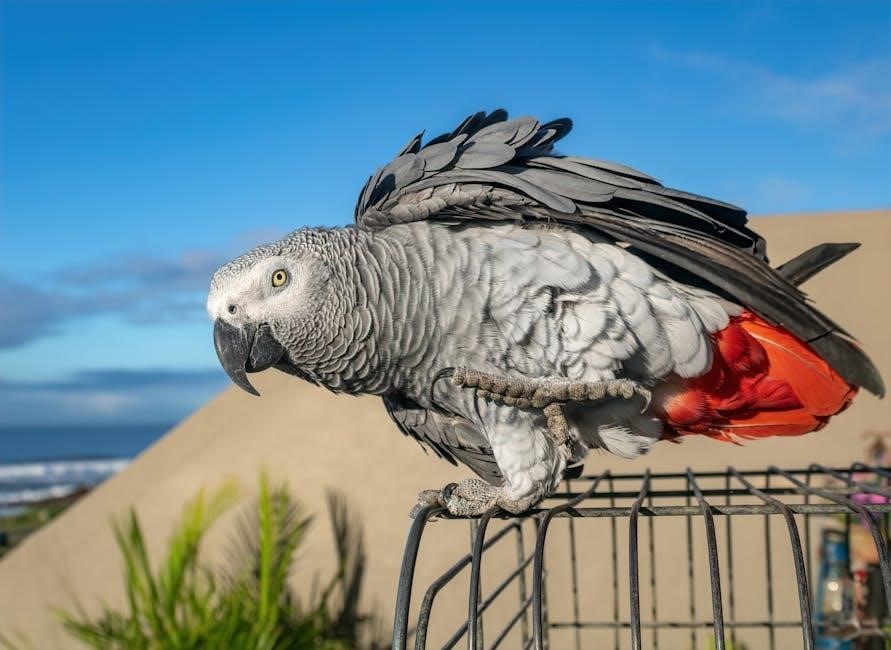“Parrot in the Oven” by Victor Martinez introduces Manny, a young Mexican-American boy navigating identity and family struggles in Fresno, California. The parrot metaphor symbolizes ignorance and growth, reflecting Manny’s journey toward self-discovery and understanding his cultural heritage.
Overview of the Book

“Parrot in the Oven” by Victor Martinez is a compelling coming-of-age novel set in Fresno, California. The story follows Manny, a young Mexican-American boy, as he navigates his identity, family struggles, and cultural heritage. The title draws from a Mexican proverb about a parrot unaware of its dangerous surroundings, symbolizing Manny’s journey from recklessness to self-awareness. Through vivid storytelling, Martinez explores themes of family dynamics, financial hardship, and the challenges of growing up in a marginalized community. The novel is praised for its authentic portrayal of the Mexican-American experience and its use of rich, figurative language. Manny’s struggles and aspirations resonate deeply, making the book a powerful exploration of resilience and self-discovery. The narrative is both deeply personal and universally relatable, offering insights into the complexities of adolescence and cultural identity.
Author Background: Victor Martinez
Victor Martinez, a Mexican-American writer, draws heavily from his cultural heritage in “Parrot in the Oven”. Born and raised in a Spanish-speaking family, Martinez was exposed to rich oral traditions, which influenced his vivid storytelling. His use of metaphors and similes reflects the linguistic richness of his upbringing. Martinez’s work is celebrated for its authentic portrayal of the Mexican-American experience, blending personal and cultural narratives. His ability to weave complex themes into relatable stories has earned him critical acclaim. Through Manny’s journey, Martinez offers a poignant exploration of identity, family, and resilience, making his novel a significant contribution to contemporary literature. His background and experiences deeply shape the narrative, creating a story that resonates with readers from diverse backgrounds.
Setting of the Story
“Parrot in the Oven” is set in Fresno, California, where Manny navigates a challenging environment shaped by cultural dynamics and social struggles, influencing his journey of self-discovery.
Fresno, California as the Primary Location
Fresno, California, serves as the vibrant backdrop for Manny’s story, where the blending of Mexican heritage and American culture shapes his experiences. The city’s agricultural landscape and economic challenges mirror the struggles of Manny’s family, highlighting themes of identity and resilience. Fresno’s diverse community provides a rich tapestry for exploring cultural tensions and social dynamics, influencing Manny’s journey of self-discovery.
The setting underscores the contrast between tradition and modernity, as Manny navigates his family’s expectations and his own aspirations. Fresno’s unique environment plays a pivotal role in shaping Manny’s understanding of his place in the world, reflecting the broader Mexican-American experience.
Cultural and Social Context
The novel is deeply rooted in the Mexican-American experience, exploring themes of cultural identity, family traditions, and social challenges. Manny’s journey reflects the struggle to balance his heritage with the pressures of modern society, creating a relatable narrative for many readers.
Socioeconomic struggles are a significant part of the story, highlighting the financial hardships faced by Manny’s family. These difficulties are intertwined with cultural expectations, emphasizing the importance of respect, honor, and community within their background.
Through vivid descriptions and metaphors, the book portrays the vibrant yet challenging environment of Fresno, where cultural richness coexists with economic adversity, shaping Manny’s perspective on his world and his place within it. This duality enriches the narrative, offering a realistic portrayal of life in a multicultural setting.

Plot Summary
Manny navigates a series of challenging summer jobs and confrontations with his father, grappling with identity and family dynamics in a vibrant yet economically strained Fresno setting.
Chapter 1 introduces Manny, a restless and impulsive teenager, as he navigates a series of unfulfilling summer jobs. His family, especially his father, expresses frustration over his lack of direction. The chapter highlights Manny’s desire to prove himself and escape the cycle of disappointment. His father’s nickname for him, “el perico” (the parrot), underscores the central metaphor of the novel, symbolizing ignorance and the need for awareness. Through Manny’s experiences, the chapter sets the stage for his journey of self-discovery and understanding his place within his family and cultural identity.
Chapter 4: The Confrontation and Its Significance
In Chapter 4, a tense confrontation erupts between Manny and his father, highlighting the family’s financial struggles and emotional turmoil. Manny’s father takes a $20 bill intended for Manny, dismissing his son’s worth by comparing him to a penny. This moment underscores Manny’s determination to prove himself and rise above the challenges of his environment. The confrontation serves as a turning point, revealing deeper tensions within the family and Manny’s growing awareness of his father’s flaws. It also emphasizes Manny’s desire to break free from the cycle of poverty and disrespect, aligning with his broader goal of becoming a “vato firme,” or a man worthy of respect. This clash is pivotal in shaping Manny’s resolve and understanding of his place within his family and community.

Characters in the Novel
The novel focuses on Manny, a young Mexican-American boy, his father, and other family members, each playing crucial roles in exploring themes of identity, culture, and struggle.
Manny (Bernardo “Nardo”) as the Protagonist
Manny, also known as Bernardo “Nardo,” is the protagonist of the novel, navigating a complex journey of self-discovery and identity. His nickname “el perico” (the parrot) reflects his father’s criticism and societal expectations. Manny strives to break free from the metaphorical oven of ignorance, seeking to become a “vato firme,” a man deserving of respect. His experiences in Fresno, California, highlight his struggles with family dynamics, cultural heritage, and personal ambition. Through his trials, Manny embodies the universal themes of adolescence and the challenges of growing up in a Mexican-American community. His story is one of resilience, as he confronts financial struggles, family conflicts, and the pursuit of self-worth in a world that often undervalues his potential.
Manny’s Father: The “Parrot in the Oven” Metaphor
Manny’s father is central to the novel’s metaphor, “el perico” (the parrot), rooted in a Mexican saying about a parrot oblivious to its surroundings. The parrot complains about the heat in the shade, unaware it is inside an oven, symbolizing ignorance and lack of awareness. Manny’s father embodies this metaphor, often prioritizing drinking over family needs, as seen when he takes a $20 bill meant for Manny. His actions reflect a broader struggle with financial instability and personal responsibility. The metaphor highlights his detachment from reality and the consequences of his choices, which deeply impact Manny’s journey. Through this, Martinez illustrates how cultural and societal pressures can trap individuals in cycles of neglect and misunderstanding, shaping Manny’s resolve to break free from such patterns.
Other Family Members and Their Roles
Other family members in “Parrot in the Oven” play pivotal roles in shaping Manny’s experiences. His mother, though often overwhelmed, serves as a voice of reason, striving to maintain stability amid chaos. Manny’s siblings, including his sisters and brothers, each face their own struggles, reflecting the broader challenges of growing up in a financially strained and culturally complex environment. Their interactions highlight the tensions and bonds within the Hernandez household. The extended family and community members further influence Manny’s understanding of his identity and responsibilities. Through their diverse perspectives and actions, these characters enrich the narrative, providing depth to the exploration of family dynamics and cultural heritage in Martinez’s vivid portrayal of a Mexican-American family’s life. Their roles underscore the interconnectedness of personal and collective struggles in Fresno, California.

Themes Explored in the Book
“Parrot in the Oven” delves into themes of identity, family struggles, and cultural heritage, exploring Manny’s journey of self-discovery and the challenges of growing up in a complex environment.
Identity and Self-Discovery
Manny’s journey in “Parrot in the Oven” revolves around his struggle to find his identity. As a Mexican-American teenager in Fresno, he grapples with cultural expectations and personal aspirations. The parrot metaphor, comparing him to a bird unaware of its surroundings, highlights his initial naivety. Through his experiences, Manny begins to recognize the importance of understanding his roots while forging his own path. His desire to become a vato firme (a man to respect) drives his self-discovery, as he navigates the complexities of family, culture, and societal pressures. This theme is central to the novel, exploring how Manny’s evolving self-awareness shapes his decisions and outlook on life.
Family Dynamics and Struggles
Family dynamics in “Parrot in the Oven” are marked by tension and struggle, particularly between Manny and his father. The father’s drinking and financial irresponsibility create friction, as seen when he takes Manny’s $20 for alcohol. Manny feels misunderstood and burdened by his father’s actions, which reflect broader familial and cultural pressures. The novel highlights the challenges of growing up in a household strained by economic hardship and generational expectations. Manny’s desire to prove himself as a vato firme contrasts with his father’s dismissive view of him as insignificant. These conflicts underscore the emotional and financial struggles within the family, shaping Manny’s identity and motivations throughout the story.
Coming of Age in a Challenging Environment
Manny’s journey in “Parrot in the Oven” is a poignant exploration of coming of age in a difficult and unforgiving world. Growing up in Fresno, California, Manny faces numerous challenges, including financial struggles, family conflicts, and societal expectations. His experiences are shaped by his part-time jobs, which often end in disappointment, reflecting his struggle to find his place. Manny’s desire to become a vato firme highlights his aspiration to earn respect and overcome the limitations imposed by his environment. The novel vividly portrays the obstacles faced by a young Mexican-American boy navigating adolescence amidst poverty and cultural pressures, emphasizing resilience and self-discovery in the face of adversity. Manny’s story resonates with universal themes of growth and perseverance in a world that often seems stacked against him.
Social Class and Financial Struggles
Social class and financial struggles are central themes in “Parrot in the Oven”, as Manny and his family navigate the harsh realities of poverty. The Hernandez family’s economic challenges are evident in their daily life, with Manny’s father often prioritizing drinking over providing for his children. Manny’s series of low-paying jobs, from dishwasher to patty turner, underscores the limited opportunities available to him. The novel highlights the tension between aspirations and economic reality, as Manny strives to rise above his circumstances. The metaphor of Manny being “just a penny” compared to the “thousand- and hundred-dollar people” reflects his feelings of insignificance in a society divided by wealth. Through these struggles, the book provides a raw portrayal of the barriers faced by those trapped in cycles of poverty and the resilience required to overcome them. Financial instability shapes Manny’s identity and his view of the world, making it a pivotal element in his coming-of-age journey.
Cultural Heritage and Mexican-American Experience
“Parrot in the Oven” deeply explores the cultural heritage and challenges of the Mexican-American experience through Manny’s journey. The novel vividly portrays the blend of Mexican traditions and American life, highlighting the tension between cultural identity and assimilation. Manny’s father uses the parrot metaphor, drawn from a Mexican saying, to critique ignorance, reflecting the generational and cultural gaps within the family. The story emphasizes the importance of understanding one’s roots while navigating a multicultural world. Martinez’s use of Spanish phrases and cultural imagery enriches the narrative, offering an authentic portrayal of the Mexican-American experience. The novel sheds light on the struggles of maintaining cultural pride amid financial and social challenges, making it a powerful exploration of identity, heritage, and resilience.

Symbols and Metaphors
The parrot symbolizes ignorance and awareness, while money represents power dynamics, highlighting the tension between financial struggles and relational bonds in the Hernandez family’s life.
The Parrot as a Symbol of Ignorance and Awareness
The parrot, referred to as “el perico,” serves as a powerful metaphor in Parrot in the Oven. It originates from a Mexican proverb about a parrot complaining about the heat in the shade, unaware it sits inside an oven. Manny’s father uses this metaphor to criticize Manny, suggesting he is equally oblivious to his surroundings. The parrot symbolizes ignorance, but it also represents the potential for awareness and growth. Manny’s journey is marked by his desire to transcend this metaphor, seeking self-discovery and understanding. The parrot’s ignorance reflects Manny’s initial naivety, while its presence in the oven signifies the hidden truths he must uncover. This metaphor underscores themes of identity and cultural heritage, highlighting Manny’s struggle to break free from cycles of misunderstanding and find his place in the world.
Money and Its Impact on Relationships
Money plays a significant role in shaping relationships within the Hernandez family in Parrot in the Oven. Financial struggles create tension, particularly between Manny and his father. The father’s misuse of a twenty-dollar bill intended for Manny highlights the emotional toll of economic hardship. Money becomes a symbol of value and disrespect, as Manny feels devalued when his father prioritizes drinking over his son’s needs. This incident underscores the broader theme of social class, where financial instability exacerbates family conflicts. The pursuit and mismanagement of money reveal deeper issues of trust and communication, illustrating how economic pressures can strain relationships and hinder emotional connections. Through these interactions, Martinez portrays the delicate balance between financial struggles and familial bonds in a challenging environment.
Literary Devices Used
Victor Martinez employs similes and figurative language to convey cultural richness and emotional depth, drawing from his Spanish-speaking heritage to create vivid imagery and resonate with readers deeply.
Similes and Their Role in Storytelling
Similes are a key literary device in “Parrot in the Oven,” enhancing the narrative’s vividness and emotional resonance. Martinez uses similes to draw parallels between everyday experiences and deeper truths, such as comparing Manny’s struggles to a parrot’s ignorance. These comparisons not only create relatable imagery but also highlight cultural nuances, making the story more engaging. By weaving similes into the text, Martinez bridges the gap between the characters’ lives and universal themes, allowing readers to connect on a personal level. This technique underscores the richness of the Mexican-American experience, making the story both authentic and accessible. Similes thus play a crucial role in shaping the novel’s storytelling, offering insights into identity, family, and societal challenges.
Figurative Language and Its Cultural Significance
Victor Martinez’s use of figurative language in “Parrot in the Oven” deeply enriches the narrative, particularly through metaphors and similes that reflect Manny’s Mexican-American heritage. The parrot metaphor, rooted in a traditional Mexican saying, symbolizes ignorance and the need for awareness, mirroring Manny’s journey of self-discovery. Martinez’s vivid descriptions, such as comparing Manny’s struggles to the parrot’s plight, create a bridge between cultural traditions and universal themes. This linguistic richness not only enhances storytelling but also highlights the complexities of identity and family dynamics within the Mexican-American experience. By weaving cultural imagery into the text, Martinez ensures that the novel resonates emotionally and intellectually, offering readers a profound exploration of heritage and growth. Figurative language thus becomes a powerful tool for cultural storytelling and thematic depth.

Reception and Reviews
“Parrot in the Oven” has received critical acclaim for its vivid portrayal of Manny’s journey and the challenges faced by Mexican-American families. Readers praise its emotional depth and relatability, while critics highlight its authentic storytelling and cultural significance, making it a powerful coming-of-age narrative.
Critical Acclaim and Reader Responses
“Parrot in the Oven” has been widely praised for its authentic and poignant portrayal of Manny’s journey. Critics highlight Victor Martinez’s ability to weave vivid storytelling with cultural depth, resonating deeply with readers. The novel’s exploration of identity, family, and societal challenges has earned it a reputation as a powerful coming-of-age story. Readers appreciate its raw honesty and relatability, particularly within the Mexican-American community. Many have praised the book for sparking important discussions about cultural heritage and personal growth. Its emotional depth and vivid characters have left a lasting impact, making it a cherished and thought-provoking read for many. The novel’s acclaim lies in its ability to balance hardship with hope, offering a narrative that feels both deeply personal and universally relevant.

Study Guide and Resources
A comprehensive study guide for “Parrot in the Oven” includes discussion questions, vocabulary lists, and literary analysis tools. PDF versions of the book and related resources are widely available online, offering readers a convenient way to access the text and supplementary materials for deeper understanding and analysis.
Key Concepts for Discussion
The novel explores themes of identity, family dynamics, and cultural heritage, making these central to discussions. The parrot metaphor highlights ignorance and growth, while Manny’s journey reflects self-discovery. Financial struggles and societal expectations add depth, encouraging readers to analyze how these elements shape Manny’s worldview. The book’s vivid portrayal of Mexican-American experiences offers rich material for exploring cultural identity and resilience. These concepts provide a foundation for meaningful dialogue about the novel’s message and its relevance to real-world issues.
Vocabulary and Literary Analysis
The novel’s rich vocabulary and literary devices enhance its storytelling and themes. Martinez uses vivid similes and metaphors, such as the parrot metaphor, to convey deep cultural and emotional meanings. The text encourages readers to analyze these devices, exploring how they reflect Manny’s growth and the struggles of his family. Vocabulary exercises, like matching words to definitions, help students engage with the language. The book’s figurative language, rooted in Mexican-American culture, adds layers of significance, making it a valuable tool for literary analysis. By examining these elements, readers gain insight into the novel’s exploration of identity, family, and resilience, while improving their understanding of literary techniques and cultural storytelling.
“Parrot in the Oven” is a powerful exploration of identity, family, and resilience, offering readers a poignant reflection on growing up in a challenging, culturally rich environment.
Final Thoughts on the Novel’s Message
“Parrot in the Oven” delivers a profound message about self-awareness, cultural identity, and resilience. The parrot metaphor underscores the importance of recognizing one’s circumstances and seeking understanding. Manny’s journey highlights the struggle to balance individual aspirations with familial and cultural expectations; The novel emphasizes the value of self-discovery and the challenges of navigating a complex, often unjust world. Through vivid storytelling and rich cultural imagery, Victor Martinez encourages readers to reflect on their own identities and the societal pressures they face. The book leaves a lasting impact, reminding us that growth and understanding are essential for overcoming adversity and finding one’s place in the world.
Impact of “Parrot in the Oven” on Readers
“Parrot in the Oven” leaves a lasting emotional and cultural impact on readers. By sharing Manny’s struggles with identity, family, and societal expectations, the novel fosters empathy and understanding. Readers, especially those from similar backgrounds, find resonance in Manny’s journey of self-discovery. The book challenges stereotypes about Mexican-American experiences and encourages reflection on cultural heritage. Its vivid portrayal of financial struggles and social class issues sparks critical thinking about inequality. The parrot metaphor, symbolizing ignorance and awareness, prompts readers to evaluate their own lives and choices. Ultimately, the novel inspires hope and resilience, reminding readers of the power of self-awareness and the importance of embracing one’s roots in navigating life’s challenges.